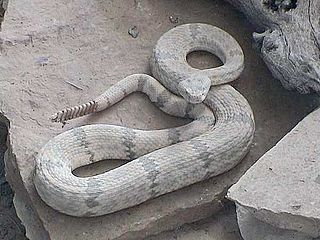
Crotalus scutulatus is a highly venomous pit viper species found in the deserts of the southwestern United States and central Mexico. It is perhaps best known for its potent neurotoxic-hemotoxic venom, which is considered one of the world's most potent rattlesnake venoms. Two subspecies are recognized, including the nominate subspecies described here.

The timber rattlesnake, canebrake rattlesnake or banded rattlesnake, is a species of venomous pit viper endemic to eastern North America. This is the only rattlesnake species in most of the populous northeastern United States and is second only to its cousins to the west, the prairie rattlesnake, as the most northerly distributed venomous snake in North America. No subspecies are currently recognized.

The black-tailed rattlesnake is a venomous pit viper species found in the southwestern United States and Mexico. Four subspecies are currently recognized, including the nominate subspecies described here.

Crotalus lepidus is a venomous pit viper species found in the southwestern United States and northern central Mexico. Four subspecies are currently recognized, including the nominate subspecies described here.

Crotalus basiliscus is a venomous pit viper species in the family Viperidae. The species is endemic to western Mexico. The specific name, basiliscus, is derived from the Greek word for king, βασιλισκος, and alludes to this snake's large size and potent venom. There are no subspecies which are recognized as being valid.

Crotalus willardi is a venomous pit viper species found in the southwestern United States and Mexico. This snake is found mainly in the "sky island" region. The IUCN reports this snake's conservation status as being of Least Concern. It is the official state reptile of Arizona.

Crotalus ruber is a venomous pit viper species found in southwestern California in the United States and Baja California in Mexico. Three subspecies are currently recognized, including the nominate subspecies described here.

The western diamondback rattlesnake or Texas diamond-back is a venomous rattlesnake species found in the southwestern United States and Mexico. It is likely responsible for the majority of snakebite fatalities in northern Mexico and the greatest number of snakebites in the U.S. No subspecies are currently recognized.

Crotalus viridis is a venomous pit viper species native to the western United States, southwestern Canada, and northern Mexico. Currently, two subspecies are recognized, including the nominate subspecies described here.

The Santa Catalina rattlesnake is a species of venomous pit viper endemic to Isla Santa Catalina in the Gulf of California just off the east coast of the state of Baja California Sur, Mexico. No subspecies are currently recognized. A relatively small and slender species, its most distinctive characteristic is that it lacks a rattle.

Crotalus enyo is a venomous pit viper species native to the coast and islands of northwestern Mexico. Three subspecies are currently recognized, including the nominate subspecies described here.

Crotalus oreganus is a venomous pit viper species found in North America in the Baja California Peninsula, western United States, and southern interior of British Columbia.

Crotalus pricei is a species of venomous snake, a pit viper in the family Viperidae. The species is endemic to the southwestern United States and northern Mexico. Two subspecies are recognized, including the nominate subspecies described here.

Crotalus lannomi, known commonly as the Autlán rattlesnake, is a species of venomous snake, a pit viper in the family Viperidae. The species is endemic to southwestern Mexico. There are no subspecies that are recognized as being valid.

The Mexican lance-headed rattlesnake or lance-headed rattlesnake is a venomous pit viper species found in central Mexico. No subspecies is currently recognized.

Crotalus stejnegeri, commonly known as the Sinaloan long-tailed rattlesnake or just long-tailed rattlesnake, is a venomous pit viper species in the family Viperidae. The species is native to western Mexico. There are no recognized subspecies.

Crotalus transversus is a venomous pit viper species found in central Mexico, known from less than 20 specimens. No subspecies are currently recognized.

Crotalus triseriatus is a venomous pit viper species found in Mexico. Two subspecies are currently recognized, including the nominate subspecies described here.

Crotalus oreganus caliginis is a venomous pit viper subspecies endemic to South Coronado Island, Mexico.
Crotalus lorenzoensis is a species of pitviper, a venomous snake in the subfamily Crotalinae of the family Viperidae. The species is endemic to San Lorenzo Sur Island, Mexico.




















